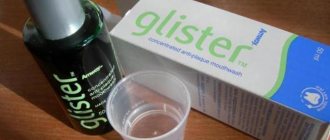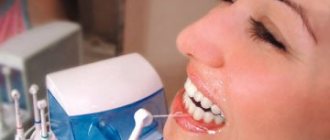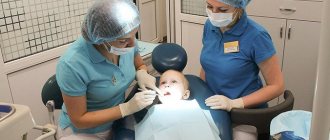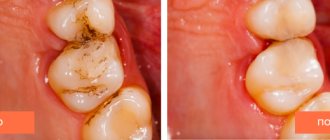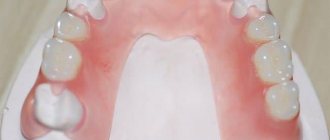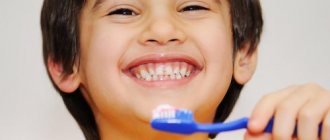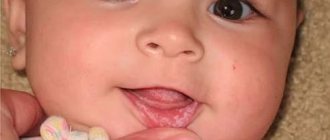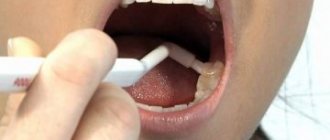From six to twelve months, babies begin to erupt milk teeth, children gradually switch to typical food, first soft in the form of porridges and purees, then harder.
This period is incredibly important for the oral cavity, since it is now that immunity is formed and the bite is formed. At this time, three hygiene products are important for care:
- wipes for cleaning.
- pacifiers - pacifiers
- gel that will relieve pain and help teeth erupt
Wipes for cleansing Wipes are used from the first month until teeth appear; it is important to choose wipes with xylitol, which have an average pH level, since they work to reduce acidity in the baby’s mouth.
How to use napkins.
You need to wash your hands thoroughly and then carefully wrap a napkin around your index finger. After this, gently, without pressing, clean the child’s entire oral cavity in a circle. First, go over the gums, then clean each tooth and tongue - this is one of the main sources of bacteria development.
Peculiarities
Visiting the dentist from an early age helps avoid fear of dental treatment in the future.
Hygiene for children has such features.
- The procedure is carried out quickly (the kids do not get tired).
- Special brushes (with high speed) and pastes are used.
- Remove soft and hard plaque, pigmented plaque, polish the enamel with special pastes;
- After the procedure, the enamel is coated with a special agent (varnish or solution) to saturate the tooth with calcium, fluorine and phosphorus ions.
Child's age: 3-4 months.
As a rule, the first teeth begin to appear in a newborn at six months of age. Is it necessary to maintain a child’s oral hygiene one and a half to two months before teething? Not all experts have the same opinion on this matter.
Some pediatric dentists believe that there is no need for any special hygiene procedures before teeth erupt.
Another group of pediatric dentists recommends starting gentle massage and cleaning of gums in children at three months of age. According to them, removing plaque, which inevitably forms on the gums as a result of feeding, will prevent the proliferation of pathogens on the mucous membrane, which will reduce the risk of caries in the future. It is also important that the child immediately gets used to hygienic procedures inside the oral cavity, and will not show resistance or be capricious when in the future it is necessary to carry out a full brushing of the teeth.
How to do oral hygiene for children under one year old
Oral care is necessary from birth, despite the absence of baby teeth. Parents should ensure that the baby does not develop thrush, a fungal disease that manifests itself as a white coating on the tongue and cheeks. When a baby's first baby tooth appears, it is necessary to properly care for it. Dentists advise using dental wipes. They are impregnated with xylitol, so they do not cause allergic reactions. The products have a pleasant fruity aroma.
When the first teeth appear, you need to buy a brush with soft bristles. Toothpaste can be used according to age, the very first from 0 to 3, as it is safe to swallow, since the baby does not know how to spit it. You will need to squeeze out a small amount of paste.
Features of oral care for children and adolescents in Ufa
Features of oral care from birth to one year
Treatment of the oral cavity must begin with the use of special dental wipes. Such napkins have a pleasant smell and taste of various fruits, which also stimulates the baby’s interest and gives a pleasant feeling. The napkins are made of a special non-woven material and impregnated with a special solution - xylitol.
It is absolutely safe for children and has a detrimental effect on pathogenic microflora. The method of using napkins is quite simple and will not cause any inconvenience to the baby and parents. Mom or dad puts a dental wipe on their index finger, takes the baby in their arms, and in a reclining position, treats the entire oral cavity of the baby. Particular emphasis should be placed on treating the child’s cheeks and, if possible, the tongue. At the time of teething, when the baby’s gums are inflamed, it is necessary to treat the gums especially carefully with light massage movements. This helps to alleviate the child’s condition, reduce discomfort and inflammation in the gums. As for the frequency of cleaning the oral cavity, like adults, children need to do it 2 times a day.
First toothbrush
From the moment of teething, it is necessary to use a finger toothbrush. It is made of silicone and comes in two types: with a fleecy and ribbed working surface. The ribbed surface removes plaque from the teeth well, but such a brush is not capable of massaging the gums, which is so necessary for teething babies. Massage can help alleviate the condition and reduce inflammation in the baby’s oral cavity. As for the fleecy surface, it not only perfectly cleans teeth of plaque, but is also capable of massage.
There is a set of toothbrushes - this is a step-by-step system for teaching yourself how to brush your teeth. The first brush for babies aged 6-8 months who have already had their first tooth. A soft rubber brush with short bristles easily cleans dirt and does not injure your baby's delicate teeth and gums.
Second brush for babies aged 8-12 months. A brush with rubber bristles prepares your baby for the transition to a regular brush. The third brush is for babies aged one to three years. At this point, the child learns to brush his teeth independently. Soft bristles remove dirt without damaging the enamel of baby teeth and gums.
Pasta selection
At each age, the requirements for toothpaste are strictly individual. The first toothpaste for a baby should be special. These toothpastes contain lactic enzymes and xylitol, which gives the toothpaste a pleasant taste that kids like so much. There are adapted toothpastes for early ages. They take into account the fact that the baby will swallow most of the toothpaste.
If the structure of tooth enamel is damaged, it is necessary to use remineralizing drugs. They effectively deal with demineralized areas of enamel - caries at the white spot stage, returning the enamel to its natural color and structure. It also helps in the prevention and treatment of caries at any stage, multiple carious lesions of the oral cavity.
Features of oral care from 1 year to 7 years
After a year, you can buy a real baby brush. The very first brush should be chosen strictly according to the child’s age - they are all marked accordingly. A children's brush should have soft bristles and the size of the working part should be such as to capture 1.5-2 baby teeth.
To stimulate the baby’s interest and create positive emotions, modern toothbrushes have multi-colored bristles, a handle in the shape of a favorite cartoon character, or with bright pictures, which makes it easier to stimulate interest and gives positive emotions from its use. The toothbrush handle should be thick, comfortable for the baby’s hand, because the joints of the hand are still poorly developed, and the baby has certain difficulties in holding a thin toothbrush in his hand. The brush needs to be changed every two months. But there are cases when the brush must be changed regardless of its service life. For example, after a sore throat or stomatitis, since there is a risk of re-infection.
It is necessary to teach a child how to brush their teeth independently at the age of 2-3 years, using game techniques that make it easier to understand and remember the sequence of actions when performing hygiene procedures. Toothpaste, in the amount indicated on the tube, should be applied to the toothbrush by an adult family member.
In general, children under 6 years of age are not recommended to use mouthwash (dental rinse). If necessary, preschoolers can use rinses (under adult supervision!) that do not contain fluoride and alcohol, which have only a deodorizing effect, using no more than 5 ml of solution per use.
To teach a child of preschool and primary school age to brush their teeth correctly, special tablets and solutions were developed that, when they enter the oral cavity, stain the remaining plaque that was not removed during brushing.
An absolutely essential component of dental care is regular visits to the dentist, because baby teeth can also get sick. In addition to examining and performing therapeutic and preventive procedures, the pediatric dentist will certainly give advice on the rules of oral care, drawing the attention of parents to points that are important specifically for their child.
Features of oral care in children over 7 years of age and in adolescents
At this age, it is necessary to strengthen and improve children’s ability to care for their teeth and oral cavity. Even after the child has mastered all the necessary steps, parents should personally supervise the teeth brushing process at least 1-2 times a week.
A toothbrush for a schoolchild should be selected according to age; the bristles should be either soft or medium soft. The shape of the working surface of the brushes can be different.
The choice of toothpaste depends on the severity of caries. If there is a high degree of caries intensity and a high risk of its development, fluoride toothpastes are used. To strengthen the enamel and eliminate caries in the white spot stage, it is possible to use remineralizing toothpastes. They promote mineralization of enamel during the growth of permanent teeth.
At the age of 12, the last baby teeth fall out, after which the child can switch to using adult toothbrushes. Then you can allow your child to use an electric toothbrush, carefully monitoring, at first, the quality of hygiene procedures.
“Smart” toothbrushes are becoming very popular. These are electric toothbrushes that sync with an app via Bluetooth so your child can see how well they brush their teeth and receive virtual rewards for it. The application collects and analyzes the duration of each procedure and collects statistics about the child’s teeth brushing; parents can set tasks for the child.
The interdental spaces for oral hygiene are the most difficult surfaces of the teeth; under no circumstances can they be cleaned with a toothbrush. Dental floss does the job that a toothbrush cannot do. It is designed to remove food fragments and plaque from interdental spaces. Even the finest toothbrush bristles cannot clean them effectively. The accumulation of plaque on proximal surfaces is fraught with the development of caries. Therefore, dental floss is not a cosmetic accessory that can be neglected, but a necessary component of oral hygiene along with a toothbrush and toothpaste. Children can floss independently from the age of 9-10 years.
The use of floss has limited application due to the anatomical features of the oral cavity and each tooth. The safest, most effective and fastest method of cleaning interdental spaces is the use of interdental brushes, which are individually selected, completely fill and clean the interdental space.
The use of rinses (elixirs) to maintain fresh breath is permitted, provided that it is an elixir specially created for children and adolescents. It will serve as an additional means to compensate for errors in brushing your teeth. A properly selected mouthwash in combination with toothpaste provides maximum care for the child’s teeth and gums, reducing the risk of caries.
An oral irrigator is the only way to remove all plaque and food debris from hard-to-reach places. This is a device that delivers a pressurized stream of liquid to certain areas of the mouth. It is she who penetrates into hard-to-reach places, removing food debris, bacteria and plaque from there. The kit may include different attachments: for cleaning the tongue, for caring for dentures and braces, and also for cleaning gum pockets.
Recommendations on visiting the dentist and eating habits remain relevant at this age.
Children's hygiene rules
Parents should consult a professional hygienist. He will show your child the correct technique for brushing his teeth. Oral care for children should include:
- Brushing your teeth twice a day.
- Replace your toothbrush 1-3 times a month.
- Using the right paste.
- Storing a clean brush in a special case with the bristles facing up.
- Using dental floss.
- Brushing time is at least two minutes.
- Consuming sweets in minimal quantities.
It is necessary to visit a pediatric dentist once every 4 months, even if there are no dental problems.
Frequency and periodicity of professional hygiene
Of course, the frequency of professional cleaning is different for each child , and depends mainly on the quality of dental care - some children brush their teeth so well that they can only be taken to a specialist annually, while others ...
When undergoing orthodontic treatment, crowded teeth or poor hygiene, preventive maintenance and professional cleaning should be performed as often as possible .
Do not underestimate the importance of professional cleaning - after all, during it, the doctor will not only teach the child how to properly care for his teeth, but will also select individual products or medications - this is especially important for various diseases or defects of the oral cavity. For example, if there is crowding, a regular toothbrush is not very effective; in this case, the child needs a special brush.
Competent selection of hygiene products for children
Oral hygiene can be a pleasant experience if you teach your child to brush their teeth correctly from an early age. Doctors advise:
- Buy your baby's first brush with very soft bristles.
- Change your toothbrush as recommended by your pediatric dentist or dental hygienist.
- Parents and children should choose the first brushes with a long handle for cleaning their teeth.
- Buy toothpaste according to the baby's age.
- Choose safe toothpastes.
Children's toothbrushes
What characteristics should a children's toothbrush meet?
- A baby's toothbrush should be attractive and bright.
- It should have an ergonomic, large handle that will not slip and fit comfortably in a child’s hand; it may have a thumb rest and a ribbed coating.
- The brush head should be small and match the height of the children's teeth, be sure to cover 2 teeth.
- The most important thing in a children's toothbrush is the bristles. Firstly, it must be artificial (natural bristles have a longitudinal pore, inside which bacteria can accumulate). Secondly, the greater the number of bristles on the working head, the better the wear resistance of the brush and the quality of teeth cleaning. More effective cleaning will be facilitated by the vertical arrangement of the bristles, the same height and its smooth transition from one area to another. The bristles on a children's toothbrush should be soft, preferably with rounded ends of the bristles. Cleaning the tooth surface should not only be of high quality, but the bristles should be gentle on the gums.
All toothbrushes can be divided into regular and electric.
Today, many large manufacturers produce electric toothbrushes for children. They have both their pros and cons. The main advantages are the ability to independently make circular and translational movements with the brush, partially reducing the load on the hand. Most often, they have a built-in timer that helps determine the minimum time required for brushing teeth, and the vibration and sounds created by such a brush allow you to prepare your baby well for dental procedures.
Each electric brush has a disadvantage - with its help it is impossible to make labor-intensive and very complex independent movements during oral hygiene measures. As a result, the child does not have the opportunity to master the skills of brushing teeth using the simplest means (for example, boating and swimming, driving a car with an automatic and manual transmission). That is why electric brushes can be recommended as an additional care product that can be used several times a week (by the child alone and with the help of parents) for oral hygiene.
Choosing a toothpaste
You can use toothpaste from the appearance of the first tooth. Gels and organic pastes are recommended for baby teeth. The packaging must indicate that the product is not hazardous if swallowed. The amount of paste should be no more than a pea. Requirements for hygiene products for babies:
- gum care;
- antibacterial effect;
- gentle and high-quality cleaning of enamel;
- pleasant taste;
- absence of harmful components.
Child's age: 9-12 months.
At the age of 9-12 months, you need to be very careful about your child’s oral hygiene. Carefully clean teeth and gums from plaque and food debris.
Hygiene products for oral care for children.
To maintain oral hygiene in the first months of a child’s life, special napkins are used.
The gums of infants have long been cleaned using a thick layer of gauze wrapped around the parent's finger. It is best to pre-moisten the fabric in warm and boiled water. Movements must be very careful and gentle, since the gums of a newborn are extremely sensitive.
However, gauze fabric is not particularly delicate - when used, there is a risk of damaging the delicate mucous membrane of the child’s oral cavity. Today, more advanced products are appearing, such as special napkins for dental care, made from the softest non-woven material or with a special textured surface. Impregnated with antiseptic, these wipes make the parent’s task much easier. For example, excellent napkins for oral hygiene for children 0-3 years old are available in the ASEPTA series.
In addition, special napkins, unlike gauze, do not cause a negative reaction from the child, since they are impregnated with the harmless sweetener xylitol. It creates a pleasant sweetish taste and, at the same time, has a positive effect on the children's oral cavity.
Sources:
- Report on determining/confirming the preventive properties of toothpaste “ASEPTA PLUS” GENTLE WHITENING” Author: doctor-researcher A.A. Leontyev, head Department of Preventive Dentistry, Doctor of Medical Sciences, Professor S.B. Ulitovsky First St. Petersburg State Medical University named after. acad. I.P. Pavlova, Department of Preventive Dentistry
- Report on the determination/confirmation of the preventive properties of personal oral hygiene products “ASEPTA PLUS” Remineralization doctor-researcher A.A. Leontyev, head Department of Preventive Dentistry, Doctor of Medical Sciences, Professor S.B. Ulitovsky First St. Petersburg State Medical University named after. acad. I.P. Pavlova, Department of Preventive Dentistry
- Clinical experience in using the Asepta series of products Fuchs Elena Ivanovna Assistant of the Department of Therapeutic and Pediatric Dentistry State Budgetary Educational Institution of Higher Professional Education Ryazan State Medical University named after Academician I.P. Pavlova of the Ministry of Health and Social Development of the Russian Federation (GBOU VPO RyazSMU Ministry of Health and Social Development of Russia)
How to teach hygiene to a child in a fun way
The procedure can become exciting if:
- buy accessories with your favorite cartoon characters;
- choose toothpaste with the flavor of your favorite berries or fruits;
- purchase flashing brushes (flashes for two minutes, indicating the required time for the procedure);
- allow the child to choose a brush or toothpaste;
- find interesting educational videos or games aimed at developing the correct technique for brushing your teeth.
The easiest way to teach children proper hygiene is by example. Arrange joint procedures, fill out special calendars, and the kids will brush their teeth with pleasure.
Basic mistakes
The main mistakes in oral hygiene include:
- Wrong size brush: too big.
- Incorrectly selected bristles: too soft or hard.
- Short duration of teeth brushing.
- Incorrect movements of the toothbrush.
- Ignoring tongue cleaning.
Remember, it is difficult to retrain a child to do anything. Therefore, dentists emphasize that it is important to teach proper oral care from early childhood.
Tartar
Tartar is a soft plaque that has been in the mouth for so long that it has hardened to such an extent that it seems to “ stick ” to the tooth. At the same time, in addition to difficulties with hygiene, the stone can cause inflammation of the marginal gum - swelling and bleeding, causing constant discomfort. As a result, children try to avoid inflamed areas when brushing their teeth.
The result of this process is gingivitis and stomatitis , and in advanced cases, gum atrophy occurs along with exposure of the dental necks. The sensitivity of teeth to temperature and other influences increases significantly .
Gum care in the first months of life
Caring for a baby's gums in the first months of life is of great importance. Dentistry "Novostom" has prepared a memo for parents.
- After each feeding, wipe the baby's gums with gauze or special wipes.
- Do not put your baby to bed with a bottle of formula (even worse than juice), as they contain a lot of sugar.
- Baby teeth need to be brushed after they emerge. To do this, use a brush or a silicone fingertip (without paste).
- Visit your dentist regularly.
Proper oral care in children can eliminate the need for future treatment. Entrust the health of your children to dental professionals.
The article was prepared by an expert:
Banina Ella Sergeevna
Dental hygienist
Make an appointment
Gels
The period of teething in a baby is one of the most troubling for parents, as it is accompanied by changes in mood, crying of the baby, fever, and sometimes more serious symptoms reminiscent of colds.
How to understand that the period of teeth growth has begun?
The main signs will be redness and swelling of the gums; in those places where the tooth will soon appear, the gums will become light. At the same time, saliva will actively begin to be released. The child, with even greater activity, puts into his mouth everything that is at hand - this helps him relieve the feeling of itching and discomfort in the mouth. Often the teething period is accompanied by a decrease in appetite, as it is painful for the baby to eat.
How can you help your child cope with the problem?
You can buy baby teethers. You can also use a special medical silicone fingertip and massage your baby’s gums - this will help relieve the itching.
Cost of children's oral hygiene
| Name | Cost, rub. |
| Comprehensive oral hygiene (deciduous occlusion) 1. determination of the hygiene index. 2. removal of dental plaque with ultrasound. 3. Air flow removal of dental plaque. 4. polishing teeth. 5. training in proper brushing of teeth. 6. recommendations for the selection of oral hygiene products. | 2200 |
| Comprehensive oral hygiene (changeable bite) 1. determination of the hygiene index. 2. removal of dental plaque with ultrasound. 3. Air flow removal of dental plaque. 4. polishing teeth. 5. training in proper brushing of teeth. 6. recommendations for the selection of oral hygiene products. | 3190 |
Child's age: 6-9 months.
During this period, teeth begin to actively cut. And what is also important is that at this age the child usually begins to receive complementary foods, which means the risk of bacterial growth inside the oral cavity increases. If dentists have different opinions regarding the previous stage of development, here they are much more definite - from the moment the first tooth erupts, active hygienic measures will be needed. During this period, the mucous membrane is very vulnerable, and the local immunity of the oral cavity decreases. With careless hygiene, the risk of developing gingivitis and stomatitis increases significantly.
Even if a tooth has barely appeared above the surface of the gum, at one edge or at one corner, it already needs to be cleaned regularly. It is also necessary to clean the gums from fragments of the complementary foods the child receives, as a result of which plaque forms.
